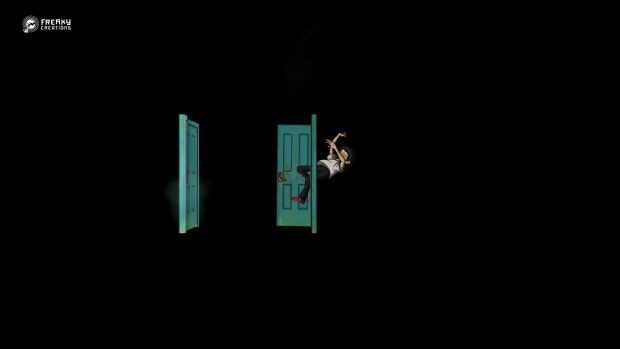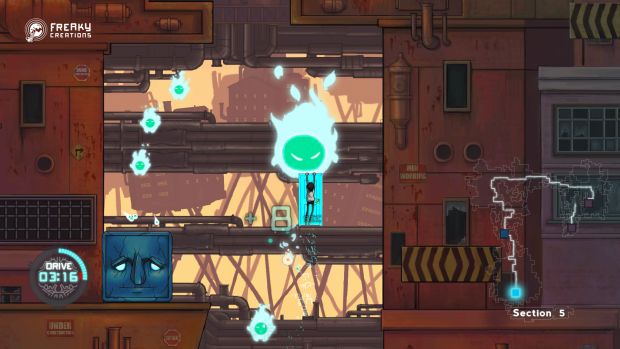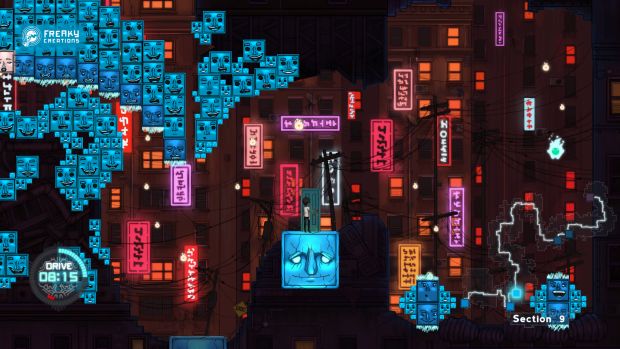
It isn’t always easy doing what you really want to do in life. There are expectations, societal pressures, bills to pay and a desire to not disappoint yourself. Ultimately, it all becomes worth it as you learn the value of appreciating what you have while still striving to a higher standard. To Leave, an indie platformer in development for PC and PS4, seeks to encapsulate that journey within the confines of a simple premise. You’ll be playing as a young man named Harm who is looking to escape the confines of the city Candice to…a better life? Riches? Opportunity? It isn’t made awfully clear but the journey to being free becomes as important as the destination in To Leave.
Creative Director Estefano Palacios and Producer Jorge Blacio of Freaky Creations believe To Leave will present an emotional journey with gameplay challenges that are relative to Harm’s trials. You’ll encounter puzzles, dexterity challenges, frustrating areas and at times, a peaceful stroll as you progress further. It’s really up to you what message you derive from the narrative but Palacios and Blacio were more than happy to share how To Leave came into being, the influences for the art style and how the game is shaping up for the PlayStation 4 and PC. Check out their responses below.
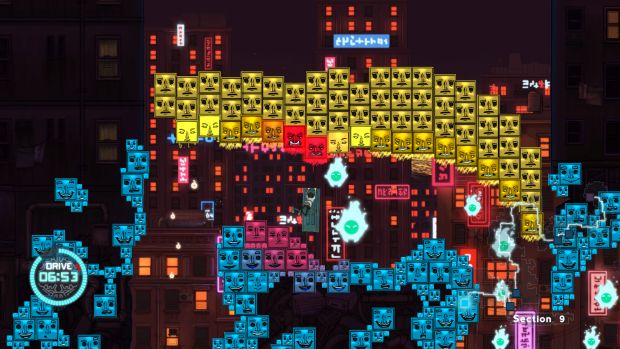
"Franz Kafka's The Trial was of great influence to envision Candice: the ravenous city that Harm lives in. Fritz Lang's Metropolis was also of great influence in this respect."
Rashid Sayed: I really like the minimalism you are shooting for with your storytelling! Ambiguity can be a powerful tool to elicit an emotional response with your audience! Were you influenced by any particular works, either games, or maybe movies or literature, that made you want to go with this method of storytelling?
Estefano Palacios: A lot of our inspiration is drawn, not from games, but from everywhere else! Personally, I’ve always been enchanted by Radiohead’s style of\composition. It might be my own personal perception, but Radiohead’s song, both its music and lyrics, morph according to the emotions you are undergoing at the moment. The ambiguity of the lyrics plays a significant role in this. One of my desires to create ambiguity in To Leave steams from seeing so many people reacts to Radiohead’s songs so differently.
Herman Hesse’s work has also been of great influence for To Leave’s story. Not necessarily for their simplicity and structure -which are\qualities I can’t say Hesse’s work posses- but for the themes it explores, and for the liberty he takes in printing the groundwork in the reader’s mind for him to derive his own meaning from the narrative. Particularly Siddhartha and Demian: both books about the search for ourselves.
Our artists presented to the rest of the team Shaun Tan, and we learned a lot from examining how elegantly he conveys so much depth in his characters and settings without uttering one word. Look at the ‘Lost Thing’ and ‘Arrival’ for examples of this.
Franz Kafka’s The Trial was of great influence to envision Candice: the ravenous city that Harm lives in. Fritz Lang’s Metropolis was also of great influence in this respect.
In terms of games, three immediately come to mind: Braid for its symbolism, and the way gameplay reinforces that symbolism\perfect through the puzzle language; Grim Fandango for its vivid characters and story structure; and Knights of the Old Republic I & II, for the (lengthy) ideological confrontations between both allies and enemies in the game.
Rashid Sayed: With To Leave, it sounds like you have a meaningful message you want to deliver; although game narratives and stories have gotten a little more meaningful over the last few years, on the whole, few games if any have anything meaningful to say. What made you want to deliver your story via a video game, instead of some other format, such as an animated short?
Estefano Palacios: In Freaky Creations we deeply believe that the format through which we deliver an experience can ultimately be a compound one. A game can be packed alongside many other interwoven formats to convey a theme. To Leave is thus a curious device composed of a game, music (with Spanish lyrics), a graphic novel-style scenes (sometimes with a generous amount of text, especially by the end of the game), and other surprises.
If an experience should be mostly a book, and only partly a game, that’s okay, for example. In the future, we want to experiment with experiences like this. Linear experiences with brief spurs of freedom and interactivity. It’s one of the reasons we’re named Freaky Creations, and not Freaky Games: we want to have that liberty to explore other format compositions later on.
At any rate, we believe the degree in which one chooses the formats to include, and the degree to which one uses those formats, really depends on a very large variety of factors, some of them in service of the message, others in service of pragmatism.
For example, sometimes the choice is one of budget and feasibility: it’s easier to put plain-text than to create an elaborate cinematic, at the expense of the player’s interest.
"Initially, the symbolism is a very obvious metaphor for the hardships of leaving your live. It's also a symbolism for the weird and dreamy world that surrounds us during our journey, as well as how that very world acts and changes to stop us from being free."
The format also selects the audience you’re talking to, both in demographics, psychographics and the population’s size. You might also want to create a strong emotional attachment between the audience and the main character. Depending on whether you want a more physical connection (the player’s feels strong through his character), or a more psychological connection (the player understands, and agrees, with the philosophies of a character), you might need to focus on making a game, a movie, a book, or a little bit of everything!
The reason To Leave has a game as its primary format, is because the game’s mechanics lend themselves really well to transmit the symbolism of the game. They add, so much in fact, that doing so primarily through other mediums would feel bland in comparison. I’ll elaborate.
Initially, the symbolism is a very obvious metaphor for the hardships of leaving your live. It’s also a symbolism for the weird and dreamy world that surrounds us during our journey, as well as how that very world acts and changes to stop us from being free.
But even though this early interpretation of the gameplay symbolism is nice, and adds the enjoyment of game’s story during the first and second acts, it’s not the crux of the matter.
The importance of gameplay symbolism becomes crucial when you enter, and fully cross, the mystical circle that is third act of our game.
I can’t say more without spoiling the game.
I must close this by saying, in honor to truthfulness, we chose To Leave because it was a theme that could be done as a game: it’s what we had most experience doing, even if some team members have a background in cinematographic production, animation, and short-story and novel writing. We also did this for all the other prototypes and projects we build prior to To Leave.
Rashid Sayed: Would you like to tell us more about the gameplay? How would you characterize it? From the videos and descriptions, it sounds like there will be a heavy emphasis on interaction with the environment.
Estefano Palacios: In To Leave Harm aims to escape the city of Candice using his Door to fly and reach its peak. Candice has an obsession to grow, and do so upwards. Candice’s peak is thus the bleeding edge of her growth. Rumor has it a Train Station exists in Candice’s peak to bring material in and out of the walled city.
The thing is, as you fly with the Door, you need to be very careful because if the Door touches anything you’ll be set back. Depending on the circumstances, Harm might be thrown back right into the life he tried to leave behind.
And so To Leave starts out like a very simple dexterity game in which you must cruise along levels in environments that get tougher and tougher. It’s really simple in this respect, but we aim it to be really entertaining and addictive too!
What’s very promising about To Leave is that, as you go, the challenges of the game start to transform in nature. As you learn to manipulate the Door perfectly, you can literally order it to do the hardest of dexterity tasks. As this happens, the game becomes a puzzler, it loses its focus on having you dodge things to have you stop, think, play around, and discover. Some of these puzzles are quite distinct in their design too. Some of them emerge naturally out of the game’s rules and systems, and yet others are designed like traditional adventure game puzzles, where the world is the puzzle, making them unique to the level they belong to.
Then the challenges change yet again, and they become a really hard combination of both elements: heads and hands. Every level becomes a game of its own, for it level has its own strategies and meaningful choices which make some of them play like a real-time version of chess.
All of this happens with the same rules you’ve been playing all along during the game.
While that sounds insane, it’s our hope to make the progression perfect for the player: that, at every moment, you have the right skill to face every change in challenge.
An interesting fact about To Leave’s gameplay is that we don’t reset the world every time you ‘die’. This means you can’t memorize a solution to a puzzle, or a challenge.
"Our game is hand painted from top to bottom. What I mean is that everything you see is how the artists paint it on Photoshop. "
Rashid Sayed: To Leave’s title is unlike many game names- was this a conscious decision to reflect your aspirations for the game’s narrative?
Estefano Palacios: It was. We like to title all projects that way, even prototypes. For To Leave, we wanted our title to hint in a very clear way the game’s theme. But we also wanted it to make special sense in hindsight, when the game has been beaten.
Rashid Sayed: The visual style of this game is arresting and stunning, particularly in the storytelling parts. It looks like an animated storyboard! Would you like to tell us about the visual inspiration for this game?
Estefano Palacios: Each of the artists has their own unique style. To Leave is really a mesh of them all: they sat together, for many days, painting and getting used to each other’s style, until they came with the style for To Leave.
The goal was to make it purposely look like a combination of different styles, and make it dreamy and beautiful, to reinforce To Leave’s theme of piercing out of reality.
I’ll post here what each of the artist wrote about their personal influences. (I’m missing Danny Camino here)
Ambar Troya – Environment Artist
I find inspiration in the following artists, both for their incredible stroke quality, color use, illumination techniques, their processes, and the way they compose their scenes.
• Loish
• Sergi Brosa
• FeiGiap
Emmanuel Ayala – Environment Artist
The colors and style of composition used in To Leave were highly influenced by Shaun Tan and Tadahiro Usagui.
Juan Perez – Animator and Narrative Scene Illustrator
The idea of a kid on a flying door came up of a series of a brainstorm silly little concept drawings I made listening Kid A and The Bends from Radiohead. It was the concept of simply leaving, and breaking free.
Main art influences:
• Alessandro Barbucci
• Yoshiyuki Sadamoto
• Akira Toriyama
Rashid Sayed: What graphical techniques are you using? Furthermore, does the PS4’s hardware enable any special tricks that you have utilized?
Jorge Blacio: Well, our game is hand painted from top to bottom. What I mean is that everything you see is how the artists paint it on Photoshop. There are some minor effects like using semitransparent planes with some sort of color gradient so that we can add that to a piece of aesthetic to produce something specific. Also we are using some custom shaders here and there, we have a refraction shader for instance, and also one that seems like it’s burning something from top to bottom.
Finally we are using layers of graphic aesthetics to convey the sense of depth in the game. So you have this sections that are composed in a way that show a 3rd dimension, even though the game is 2D. We have levels with up to 11 layers of depth.
On the PS4 we haven’t yet really explored specific tricks that we can pull, but we are on it.
"The Incubation program has allowed us to get To Leave on the PlayStation platforms. They give us access to devkits, without any cost. They invite us to events like GDC so that we can expose our game."
Rashid Sayed: Considering the emphasis on the interaction with the environment, do you use the special methods of input? Maybe utilizing the touchpad/touch screen on the PS4/Vita? Support for the camera, or motion controls?
Jorge Blacio: We haven’t used any special methods of input just yet. We have prototyped some things, like using a touch screen to see how well would that played out, but we want to have a simple input that can generate emergent gameplay. But if we end up adding support to any special input, we’ll let you know.
Rashid Sayed: So like a lot of other indie developers, it seems you too were attracted by Sony’s pro indie and developer friendly policies. How would you describe your experience of working with Sony, especially with regards to their Latin America Incubation Program?
Jorge Blacio: Working with Sony has been awesome. In fact, I dare to say that it has been the door that took us to the big leagues. It would have taken years to get to the point we are now without them. They are really open to hear anything you have to say and give you honest feedback. On the Latin American Incubation Program, the people I talked with the most, are Mike Foster and Bruno Matzdorf. Both of them great persons, and really working their asses to help developers like us. They always say honestly what they are thinking and always try to see a way to help us.
The Incubation program has allowed us to get To Leave on the PlayStation platforms. They give us access to devkits, without any cost. They invite us to events like GDC so that we can expose our game. They present us to know indie developers, so that they can advise us. All of this things are really impossible to get here on Ecuador.
Rashid Sayed: Making a game for the PlayStation 4 is probably a natural decision, given Sony’s policies, in addition to the PS4’s high hardware and software sales. But what prompted you to put it on the Vita as well, which is a riskier proposition?
Jorge Blacio: That’s a good question. The thing is we got the PS Vita kits before the PS4 devkits. Of course that wasn’t what settled the decision. But when we had to present something at GDC we only had the Vita Kits. So we started porting what we had to the PS Vita. It was a really interesting experience and we learned a lot from it. But let me tell you, we would never put To Leave on a platform that wouldn’t let the game express to its fullest.
The PS Vita felt really good for To Leave. I could see myself playing To Leave on the go, easily. But what we learned for our porting experience was that probably, the both version couldn’t come out at the same time. But both version will be something we would love to see out there for the players. So that’s why we decided to do the Vita version as well as the PS4 version.
" To Leave is not as resource intensive as a full 3D AAA, but it does have its moments when it demands the hardware a bit. Mostly because of the physics, but this has been optimized a lot by us at this point."
Rashid Sayed: Is there any chance of us ever seeing it on a non Sony console or handheld? May be the Wii U?
Jorge Blacio: We would love to spread our game as far as we can, and that players play it on their favorite platforms. With that said, I can tell you that other platforms are something that could happen. But for now we are focusing on Sony’s consoles.
Rashid Sayed: Are there any plans to bring the game to the Xbox One? If not, why?
Jorge Blacio: Not at this moment really. As an indie you have to focus on a little set of platforms if you don’t want to go nuts. Right now we are focusing on Sony’s because of their willingness to help us. We haven’t had such an approach from Microsoft. I don’t want this to be taken in a way that states that Microsoft is not willing to help developers like us. But I don’t know since I haven’t had the chance to talk to them. It’s not something we are avoiding, is just something that we are not looking for right now.
Rashid Sayed: To Leave does not seem to be a resource intensive game, so is it safe to assume that it will have no problems running 1080p at 60fps on the PS4?
Jorge Blacio: Well yeah, To Leave is not as resource intensive as a full 3D AAA, but it does have its moments when it demands the hardware a bit. Mostly because of the physics, but this has been optimized a lot by us at this point. So it is safe to say that To Leave sill run at 1080p at 60fps on the PS4.
Rashid Sayed: What can you tell us about the engine the game is running on? How hard or difficult was it to integrate with the PS4’s architecture?
Jorge Blacio: We are using Unity with some extensions created by us. The exporter of Unity for the PS4 is still been worked on, so probably later on will be a lot more robust. Although right now is not such a problem, the engine does well on the console, mostly because of the architecture of the PS4 that is really similar to a PC, a very powerful one. So porting the game from PC to PS4 has been no much of a problem. Sometimes you have some porting nonsense, mostly on the graphic part. Like a shader works on PC that won’t work on the platform, but is mostly because of how the shader is written and sometimes is as easy as to add a couple of lines to it and you have it working on both PC and PS4.
Rashid Sayed: From a technical perspective, the PS4 features GDDR5 RAM that has a bandwidth of 176GB/s and a GPU that is very much capable of rendering 64 bit textures. Do you think with games like The Order 1886 and inFamous, we are only seeing at the tip of the iceberg of what the PS4 is truly capable of?
Jorge Blacio: As with all generations of consoles, I think that when we the developers get more comfortable and more adept with the hardware, just as right now the PS3 and Xbox360 are at, the hardware stops been something you get to worry. And you just start to translate your ideas to the screen, without worrying about technology. So that’s why I think in the future, we’ll be seeing a lot more from this generation, I am really excited for that.
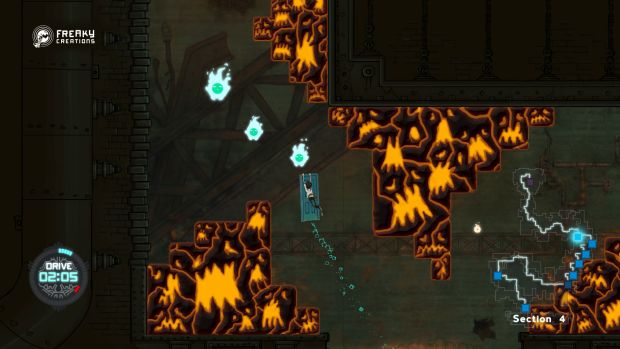
"We have tons of game ideas on the background. And quite honestly, we really want to finish To Leave: we just don't want to ship a game that doesn't do full justice to the theme."
Rashid Sayed: To Leave will also release on the PC. I am sure you must be aware that Microsoft recently announced DX 12. What are your thoughts on the same and how it can possibly impact games development on PC and Xbox One?
Jorge Blacio: Well I think this will be something that will play out for the better for both of those platforms. DX12 has some new interesting features, and this will surely boost the Xbox One possibilities, which is good, since this will also prompt Sony to boost the PS4, and this competition is great for our industry. On the PC side, we will start seeing a lot of crazy stuff, people on the PC side of things always like the eye candy more and surely you will have insane things running on insane rigs.
Rashid Sayed: What’s next for your studio? Do you see yourself revisiting Candice? Or are there other stories you want to tell that you hope to be able to tell?
Estefano Palacios: Well, we’re not really done with To Leave to begin with (joking). And all our efforts are concentrated into bringing the best story and experience as possible. With all our ambitions for the game, it may all end up in disaster, but that’s okay.
At this moment we don’t see revisiting Candice, or any of To Leave’s characters for that matter. In Freaky Creations we want to do a no-sequel philosophy, for now. In the case of To Leave, we really want to put in there everything related to that theme, do it as impeccably as we can, and move on.
After To Leave we want to start all over again. We want to go into the shadows for a whole year and do depth jams all year round. We want to develop the storytelling and design skills of every team member, as well as let them deepen their understanding of their specific trade. We also want to explore other combinations of mediums and formats, even try games only as a secondary or tertiary format.
We have tons of game ideas on the background. And quite honestly, we really want to finish To Leave: we just don’t want to ship a game that doesn’t do full justice to the theme. To Leave must enrich, empower and nourish its players. If it doesn’t, we’ve failed. That’s why we keep at it.








